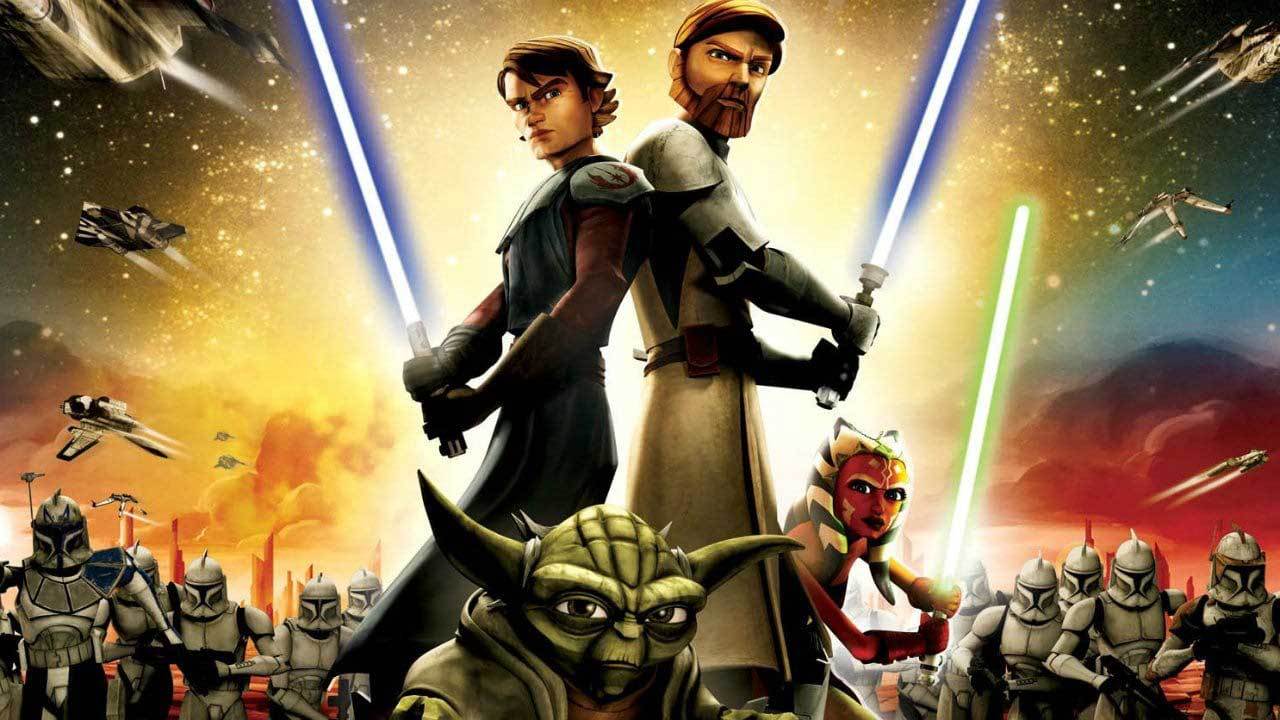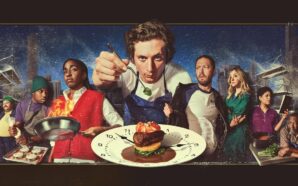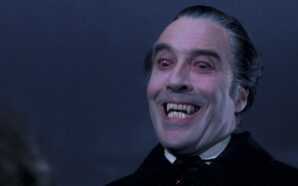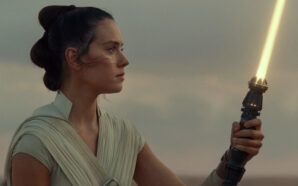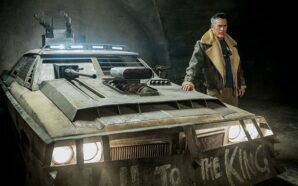It seems with every Star Wars film released, the fanbase grows increasingly divided. But through the torrent of discord and disjunction there’s been one shining light that’s unified every Star Wars fan for the past decade or so: The Clone Wars. The animated series has become beloved by fans of every era and generation, and features some of the best Star Wars storytelling ever produced. It’s bittersweet then that the previously cancelled series returned for one last hurrah earlier this year, finally concluding the story that began over 12 years ago. However, the series wasn’t always so adored.
Before the inconsistent opening seasons, The Clone Wars began with an impromptu animated movie which cobbled together the episodes that would have been the first arc of the series but instead were shown in theatres to thunderous booing. The reaction was largely negative and significantly damaged fans’ relationship with the series. After its failure, the rapidly improving show took years to acquire the fanbase it now has. With the series now concluded – the final arc possibly being the show’s best – and a spin-off on the way, I thought I’d revisit the infamous movie that started it all and wonder whether, in retrospect, it’s better than we all thought.
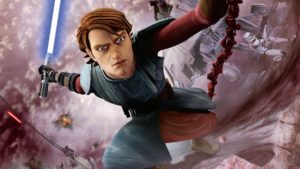 It begins unlike any Star Wars movie before it. There’s no “A long time ago…” but rather the sound of clones in the heat of battle; John Williams’ classic theme has been replaced by a warped version with extra drums; and a narrator yells exposition instead of including an opening crawl. This was an utterly bizarre beginning back in 2008 and one many fans immediately dismissed. But now, after over 100 episodes of the show, it’s just an accepted, if not relished, part of The Clone Wars. Instead of leaping into the action like a Star Wars film aimed at young children probably should, the film takes a lead from its fellow prequels and begins with some political discussion in Palpatine’s office. Jabba the Hutt’s son has been kidnapped and Obi-Wan and Anakin – currently entrenched on the planet Christophsis – are tasked with retrieving the young Huttlet to secure a hyperspace lane treaty with the Hutt cartel. Meanwhile, Anakin is tasked with mentoring a young padawan, Ahsoka Tano.
It begins unlike any Star Wars movie before it. There’s no “A long time ago…” but rather the sound of clones in the heat of battle; John Williams’ classic theme has been replaced by a warped version with extra drums; and a narrator yells exposition instead of including an opening crawl. This was an utterly bizarre beginning back in 2008 and one many fans immediately dismissed. But now, after over 100 episodes of the show, it’s just an accepted, if not relished, part of The Clone Wars. Instead of leaping into the action like a Star Wars film aimed at young children probably should, the film takes a lead from its fellow prequels and begins with some political discussion in Palpatine’s office. Jabba the Hutt’s son has been kidnapped and Obi-Wan and Anakin – currently entrenched on the planet Christophsis – are tasked with retrieving the young Huttlet to secure a hyperspace lane treaty with the Hutt cartel. Meanwhile, Anakin is tasked with mentoring a young padawan, Ahsoka Tano.
The film acts as a pilot for the series and, only a few minutes in, Yoda sets out the premise of the whole show. Sure, it’ll delve into all aspects of the war and the clones themselves but the emotional core of series is the relationship between Anakin and Ahsoka. Yoda states he’s paired them together for the purpose of them building an attachment, only to make them let go of one another when Ahsoka’s learnt all she can from her new master. It’s his ploy of combating Anakin’s struggle with attachment – by forcing him to eventually let her go. With this one line, Yoda describes the arc of the series and the intended endpoint, which we now know will come to pass in the most unexpected of ways. That relationship between master and apprentice is maybe the best part of the movie and the initial introduction of the characters is fairly well done. The sibling dynamic is instantly there, and the similarities and differences between the two are clearly defined. There’s just one problem. Ahsoka is, dare I say it, annoying.
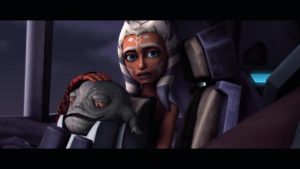 Upon the film’s release, Ahsoka was hated. While I think the ferocity of anger and distaste was dramatically overblown, as it is with most modern Star Wars discussion, Ahsoka is pretty far from the fan favourite character she becomes. Most of the character work is good, with Ahsoka already being the right level of impulsive and emotional to make for a good pairing with Anakin, while also being much stricter about the Jedi code, keeping them on mission when Anakin’s problem with attachment rears its head. As they work together and form a friendship you can see how, through their relationship, she will become a better Jedi – maybe the best – while he’ll tragically become a Sith.
Upon the film’s release, Ahsoka was hated. While I think the ferocity of anger and distaste was dramatically overblown, as it is with most modern Star Wars discussion, Ahsoka is pretty far from the fan favourite character she becomes. Most of the character work is good, with Ahsoka already being the right level of impulsive and emotional to make for a good pairing with Anakin, while also being much stricter about the Jedi code, keeping them on mission when Anakin’s problem with attachment rears its head. As they work together and form a friendship you can see how, through their relationship, she will become a better Jedi – maybe the best – while he’ll tragically become a Sith.
It’s just that the balance between keeping everything fun and kid friendly and allowing for actual character drama that appeals to older fans hasn’t been settled on yet. The film doubles down on Ahsoka being a child’s proxy character – the Robin to Anakin’s Batman – and her cutesy and childlike nature is taken to the extreme. I cringe every time they call each other “Snips” and “Skyguy”, R2-D2 is suddenly “Artooie”, and they try to go for the cute factor with Rotta ‘Stinky’ the Hutt and it misfires. He’s no Baby Yoda, that’s for sure.
It’s not all sunshine and syrupy saccharine nicknames however. There’s a war on! The film highlights just how much The Clone Wars was Lucas’ ultimate sandbox. It was his place to play around with any aspect of Star Wars he wished, with a variety of tones. It’s a series that could accommodate the dark war drama of the Umbara arc or the light-hearted tales of a group of droids trapped in a sunny void – Lucas’ personal favourite episode. In the series, he and the team led by Dave Filoni made these drastic changes work, all against the backdrop of one of the darkest points of the timeline. The thing is that those tones work in their own episodes, but with the film stitching several different episodes with different tones together, it doesn’t work. At all. The movie quickly switches from huge battles with clones getting mowed down to Buster Keaton inspired gags; decapitated heads to jokes about Jabba calling his son “punky muffin”. And while I’m a fan of the prequels, this film is even more prequel-ly than the prequels. Jabba’s uncle Ziro is a camp noir villain who runs a Jazz bar and sounds like Truman Capote. It’s a little too silly even for me, and I love silly Star Wars!
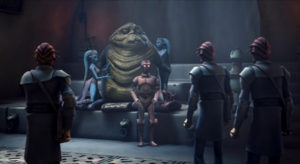 Whilst Yoda sets out the story and emotional lynchpin of the series going forward, Palpatine similarly sets out the themes. As with most of Palpatine’s machinations, his schemes in the film are on one hand needlessly complicated and on the other painfully simple. Unlike The Rise of Skywalker where he literally announces to the galaxy that he’s just going to blow up every being who doesn’t follow his rule, Sheev is continuing his prequel-style subtle manipulations of both sides of the Clone Wars. And it’s a good plan. Either Jabba believes the Jedi kidnapped his son, bringing him into the war against the already stretched Republic, or the Jedi prove their innocence and are cleverly forced into making a deal with the crime boss, corrupting their noble nature even further. At one point the Jedi are even coerced into becoming assassins working for Jabba. This examination and condemnation of the Jedi of the prequel era, exacerbated by Palpatine’s plots, is a key theme of the series going forward, culminating in one of Star Wars’ greatest moments: Ahsoka leaving the order in season 5.
Whilst Yoda sets out the story and emotional lynchpin of the series going forward, Palpatine similarly sets out the themes. As with most of Palpatine’s machinations, his schemes in the film are on one hand needlessly complicated and on the other painfully simple. Unlike The Rise of Skywalker where he literally announces to the galaxy that he’s just going to blow up every being who doesn’t follow his rule, Sheev is continuing his prequel-style subtle manipulations of both sides of the Clone Wars. And it’s a good plan. Either Jabba believes the Jedi kidnapped his son, bringing him into the war against the already stretched Republic, or the Jedi prove their innocence and are cleverly forced into making a deal with the crime boss, corrupting their noble nature even further. At one point the Jedi are even coerced into becoming assassins working for Jabba. This examination and condemnation of the Jedi of the prequel era, exacerbated by Palpatine’s plots, is a key theme of the series going forward, culminating in one of Star Wars’ greatest moments: Ahsoka leaving the order in season 5.
I just wish the film could explore these fascinating themes while also creating an enjoyable moment-to-moment story rather than a stinky Macguffin hunt that takes far too long. The film is very awkwardly plotted and it’s apparent that it’s simply composed of multiple episodes stitched together, with some extra scenes acting as a bridge between them. You can almost feel where the ad breaks would be. The final arc of the series would work better edited together as a movie than this introductory outing. 74 minutes in, Padme suddenly appears and for the next 20 minutes we follow her for what was clearly a standalone episode that has been absorbed into the film. I enjoy Padme’s episodes of the show but she doesn’t quite fit in the film and needed to be introduced much earlier. The third act tries to intercut different stories but fails, ultimately eliminating any tension rather than creating it.
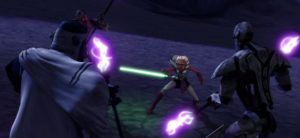 The film, however, is not overly concerned with plot and structure, opting rather for wall-to-wall action. The titular wars are near constant and incredibly tiring, making the poorly paced film feel like the saga’s longest when it’s actually by far the shortest. We get maybe five minutes of plot and quiet character moments, followed by countless sequences of clones and droids running at each other while shooting. Christophsis, Teth, Tatooine: if there’s a planet there’ll be a battle for it, and we’ll see far too much of it. It’s not that I don’t enjoy the series’ animated action, it’s just that it feels so stale and repetitive here. This will continue on into the first season of the series but, as the show does in every aspect, it’ll improve dramatically and ultimately offer countless dynamic action scenes. Here, it’s just boring. The scale of the action is oddly frontloaded too. The first and second acts are filled with huge battles and warring armies while the third keeps things much smaller, with Ahsoka facing off against MagnaGuards being the biggest moment. This isn’t necessarily a problem – the quaint third act of Solo works decently well – but after so many explosions it just feels as if the film peters out.
The film, however, is not overly concerned with plot and structure, opting rather for wall-to-wall action. The titular wars are near constant and incredibly tiring, making the poorly paced film feel like the saga’s longest when it’s actually by far the shortest. We get maybe five minutes of plot and quiet character moments, followed by countless sequences of clones and droids running at each other while shooting. Christophsis, Teth, Tatooine: if there’s a planet there’ll be a battle for it, and we’ll see far too much of it. It’s not that I don’t enjoy the series’ animated action, it’s just that it feels so stale and repetitive here. This will continue on into the first season of the series but, as the show does in every aspect, it’ll improve dramatically and ultimately offer countless dynamic action scenes. Here, it’s just boring. The scale of the action is oddly frontloaded too. The first and second acts are filled with huge battles and warring armies while the third keeps things much smaller, with Ahsoka facing off against MagnaGuards being the biggest moment. This isn’t necessarily a problem – the quaint third act of Solo works decently well – but after so many explosions it just feels as if the film peters out.
This is not to say all the action is dull. There are some moments worth highlighting that are mainly memorable for Dave Filoni’s camera work, giving us a taste of the directing prowess that he’ll fully develop in future Star Wars animation, and now live-action. Following Lucas’ direction of the battles in the prequels, the virtual cameras shake and shudder with nearby explosions in an attempt to create some sort of realism. My favourite moment might be the lead up to the battle on Teth, as we see Anakin, Ahsoka and the clones prepare for battle on a drop ship, cocking their blasters and sharing tensive glances. That pre-battle tension is something the series will continue to do well and made me think of season 2’s action spectacular ‘Landing at Point Rain’. The battle that follows is pretty good too, particularly the AT-TE walkers climbing the vertical wall to the monastery. However, the music that accompanies the scene leaves much to be desired. Composer Kevin Kiner is toying with what Star Wars music can be and pushing the boundaries in new ways, but to reach the enormous heights of the Blade Runner-esque soundscapes of the show’s final season, he first has to fail with his misguided rock music in the film.
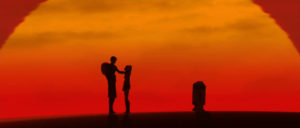 As with the score, the animation will improve dramatically between this initial feature film and the recent final season of the show. It’s probably unfair to compare the two, but even without prior knowledge of just how good The Clone Wars will eventually look, the film is clearly filled with rushed and clunky animation that wouldn’t be too impressive on the small screen, let alone the big. Some of the lighting is good, especially the silhouettes against the setting twin suns of Tatooine, but overall, it’s an ugly film. The lightsaber fights are very awkward and feature characters basically standing still while moving their arms, occasionally jumping to another corner of the room to repeat their moves. The Maul/Ahsoka fight in the show’s final arc may have ruined all previous animated duels because of the brilliant motion capture that was utilised. It’s all about movement, specifically the legs. That battle with Maul was so good because every step, skip and leap felt natural and clearly belonged to Ray Park. Here, the characters are too static and move nothing but their hands and lightsabers.
As with the score, the animation will improve dramatically between this initial feature film and the recent final season of the show. It’s probably unfair to compare the two, but even without prior knowledge of just how good The Clone Wars will eventually look, the film is clearly filled with rushed and clunky animation that wouldn’t be too impressive on the small screen, let alone the big. Some of the lighting is good, especially the silhouettes against the setting twin suns of Tatooine, but overall, it’s an ugly film. The lightsaber fights are very awkward and feature characters basically standing still while moving their arms, occasionally jumping to another corner of the room to repeat their moves. The Maul/Ahsoka fight in the show’s final arc may have ruined all previous animated duels because of the brilliant motion capture that was utilised. It’s all about movement, specifically the legs. That battle with Maul was so good because every step, skip and leap felt natural and clearly belonged to Ray Park. Here, the characters are too static and move nothing but their hands and lightsabers.
It’s hard not to think of the series’ dramatic and unexpected conclusion while revisiting the film that started it all, and despite the contrast of overall quality, they work as interesting bookends. Anakin and Ahsoka’s first encounter is painful to watch now after seeing their final interaction in The Clone Wars, as well as Ahsoka’s fateful confrontation with Vader in Rebels. The battle on the raised walkways of Christophsis is even explicitly mirrored in the show’s final arc with the battle on the bridge on Yerbana. We also see the beginning of the relationship between Ahsoka and the clones, which will pay off in ‘Old Friends Not Forgotten’ when they choose to fight with her and paint their armour in her colours. Ahsoka forms a bond with Rex as they discuss experience, and regales troopers with stories of her adventures, making their betrayal via Order 66 even more heart-breaking.
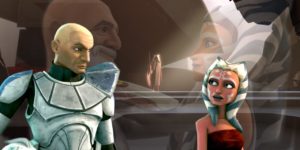 The film is not only the beginning of Ahsoka’s journey, but that of the clones too. The series will go on to reveal the hidden character depths of the expendable army in ways the core films never could, and that begins in this animated feature. Not only do we witness relationships forming between soldiers and their generals, but also the clones show emotion and begin to resemble individuals. Rex even resists a mind trick at one point, showing them not to be as weak minded as other characters, and maybe viewers may think. It even brings to mind Rex’s initial resistance to Order 66 in the devastating finale of the series. It is a shame however that more isn’t explored with the clones in the film. While we begin to understand them as individuals, it would have been great to hear more of their unique names and see their modified armour that the series will later present.
The film is not only the beginning of Ahsoka’s journey, but that of the clones too. The series will go on to reveal the hidden character depths of the expendable army in ways the core films never could, and that begins in this animated feature. Not only do we witness relationships forming between soldiers and their generals, but also the clones show emotion and begin to resemble individuals. Rex even resists a mind trick at one point, showing them not to be as weak minded as other characters, and maybe viewers may think. It even brings to mind Rex’s initial resistance to Order 66 in the devastating finale of the series. It is a shame however that more isn’t explored with the clones in the film. While we begin to understand them as individuals, it would have been great to hear more of their unique names and see their modified armour that the series will later present.
I feel I’ve been largely negative on the film so far, and while it’s ultimately not very good and a wobbly first step into animation for the franchise, there are some moments I enjoy. Obi-Wan gets to present one of his “alternatives to fighting” when, in between bouts of droid slaughter, he negotiates surrender with the aptly named General Loathsome. It’s just that it’s not his surrender he’s negotiating but the General’s because Anakin and Ahsoka are secretly disabling a shield generator while Kenobi acts as the distraction. It’s a wonderful little scene showcasing Obi-Wan as a negotiator, sipping “something liquid” with the enemy, while also further twisting the Jedi doctrine as the prequel era is wont to do, tricking his opponent in a very dishonest way. Likewise, Anakin has a few good character moments, particularly him quoting Qui-Gon to Ahsoka, and his fear of returning to Tatooine after his mother’s death. There should have been more conflict with Anakin having to return the Huttlet to the crime lord that runs criminal enterprises on the planet of his former enslavement, but I’ll take what I can get from this film.
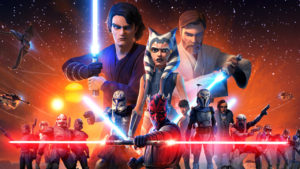 So, do I appreciate the film more now than I once did before I watched the series? Well, yes and no. In terms of introducing themes and relationships, it’s a decent elongated pilot for what the series will become, but as a film unto itself it fails. Many of its problems spawn from the foolish decision to edit several episodes together and rush it into theatres as a movie, with the pacing, structure and just basic plot being problematic. The animation is rough and, while it should absolutely aim to appeal to children more than the saga films, the humour and tone are unsettled. Upon revisit, there is a certain charm to the small beginnings of the show we’ll come to love, including the annoying introduction to the now fan favourite Ahsoka, and fun details that bookend the series with the final arc. There are certainly more things to enjoy when returning to the film after the series is complete, but there’s no getting away from the fact that it’s still a bad movie.
So, do I appreciate the film more now than I once did before I watched the series? Well, yes and no. In terms of introducing themes and relationships, it’s a decent elongated pilot for what the series will become, but as a film unto itself it fails. Many of its problems spawn from the foolish decision to edit several episodes together and rush it into theatres as a movie, with the pacing, structure and just basic plot being problematic. The animation is rough and, while it should absolutely aim to appeal to children more than the saga films, the humour and tone are unsettled. Upon revisit, there is a certain charm to the small beginnings of the show we’ll come to love, including the annoying introduction to the now fan favourite Ahsoka, and fun details that bookend the series with the final arc. There are certainly more things to enjoy when returning to the film after the series is complete, but there’s no getting away from the fact that it’s still a bad movie.
However, it’s a testament to just how much Dave Filoni and his team have improved their craft and were given time to grow. From this movie to the ‘Siege of Mandalore’, every aspect has been improved upon and I can’t wait to see how the creative team continues to innovate and tell new stories in the years to come.
To wrap up, here are a few extra random thoughts on film:
- With the movie having a notable theatrical release, several actors from the prequels reprise their roles before being replaced by cheaper performers for the series. While Corey Burton does a great job of voicing Dooku in the series, it’s a thrill to have Christopher Lee return and say more weird Star Wars words than ever before. On the opposite end of the spectrum, Sam Jackson has never sounded so bored with his few lines as Mace Windu in the film.
- While I dislike ‘Stinky’ Rotta the Hutt and his role in the film, I would love to see him again in a future project. An older Rotta trying to hold his recently deceased father’s empire together could make for a great episode of The Mandalorian.
- While we all love a “I have a bad feeling about this”, the film lays on the quotes and references maybe a little too much.
- We get a brief cameo by a holographic doctor which has to be a fun nod to Star Trek: Voyager.
- While the film is set soon after Attack of the Clones, I wish it was even closer to that movie in the timeline. I can’t believe we still haven’t seen how Anakin gets his scar or the first meeting with Ventress. Not to mention the Skywalker lightsaber, which is such an iconic object in all three trilogies, currently has no origin. Anakin just has it at the start of the film.
- I completely forgot about the Twilight – the spice freighter that Anakin steals in the film. It was no doubt included to make the “navigator on a spice freighter” line from A New Hope have some truth to it. Apparently, it was supposed to be a big part of the series going forward but only appears a few unmemorable times.
Have you revisited the infamous film since the beloved series it spawned ended? Have you changed your opinion since your first viewing? Let me know in the comments and be sure to geek out with me about TV, movies and video-games on Twitter @kylebrrtt.




